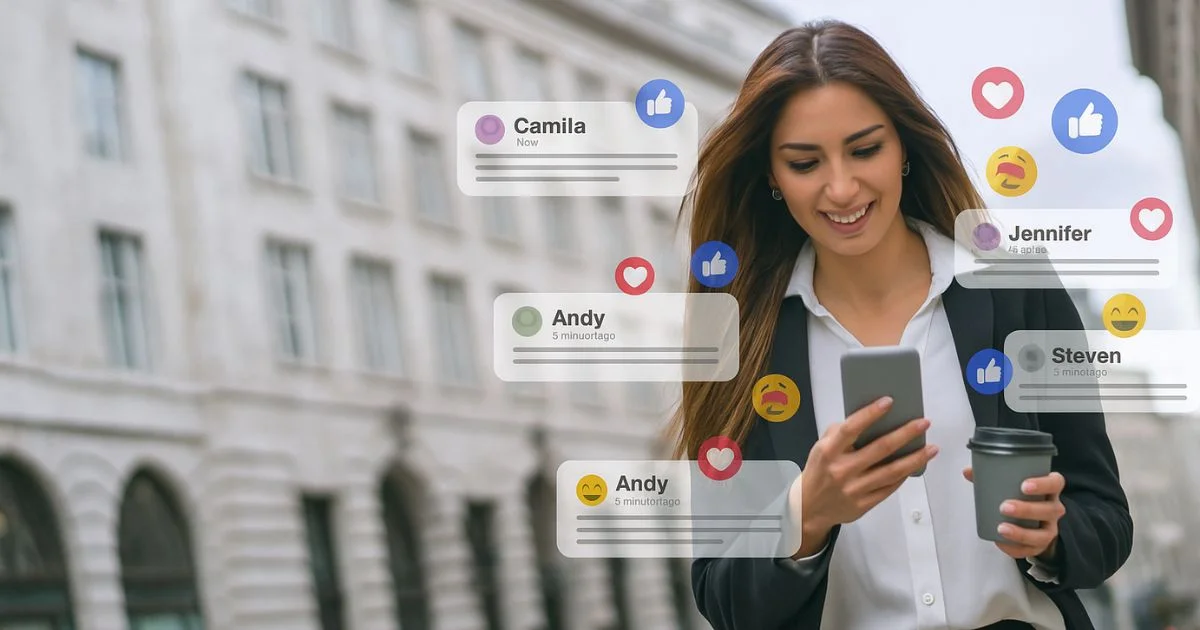Who am i online? Rethinking identity in the social media era
Adolescence and young adulthood, typically spanning from ages 12 to 25, are pivotal periods for identity formation. These years mark a progressive shift away from the family of origin, the exploration of new social affiliations, the shaping of personality, and the search for one’s unique place in society. Today, this crucial phase of development is inextricably linked to the digital environment. Social media platforms are no longer mere communication tools; they have evolved into hybrid social arenas where relationships are formed, cultural norms are disseminated, and individual as well as collective identities are shaped.
Far from being neutral technologies, these platforms are complex sociotechnical systems that profoundly influence how young people construct, present, and perceive their own self-image. This article explores the phenomenon from a sociological perspective, examining how social structures, emerging norms, and online interactions are reshaping identity processes, through the lens of key concepts in contemporary sociology.
Digital socialization of identity
Sociology defines socialization as the continuous and dynamic process through which individuals learn and internalize the norms, values, codes of conduct, social roles, and behavioral models of their society. This process enables individuals not only to build a sense of self but also to function appropriately within the social fabric. Traditionally, the family and the school system have been viewed as the primary agents of socialization, primary and secondary, respectively. In the digital era, social media has emerged as a powerful secondary socialization force. For so-called “digital natives”, those born into a world shaped by digital technologies, it may even function as a form of primary socialization due to its early and pervasive influence.
First, these platforms introduce new norms for self-presentation and identity management. In his seminal work The Presentation of Self in Everyday Life (1959), sociologist Erving Goffman described the intricate strategies individuals use to perform their identities and manage impressions during social interactions. He spoke of “personal fronts” and performance “regions” (frontstage and backstage). On social media, impression management becomes exponential, constantly solicited, performed, and mediated. User profiles are carefully curated digital façades, where every detail, from profile pictures and captions to stories and listed interests, is meticulously selected, edited, or filtered to construct a coherent and appealing image. The use of photo editing apps, beauty filters, and video editing tools is no longer limited to professionals; it has become commonplace among youth. This pursuit of the “ideal self-presentation” contributes to the normalization of idealization, often at the expense of raw authenticity, which is traded for a more simplified, socially rewarding version.
🔗 Read also: Repressed and reloaded: Psychoanalysis in the age of social media
Second, social media redefines reference groups and the dynamics of social conformity. Adolescents and young adults are immersed in virtual communities that transcend geographic and traditional social boundaries. Whether in online friend groups, celebrity fan pages, thematic niches (fitness, fashion, gaming), or activist collectives, belonging to these circles entails adherence to specific codes, shared languages, fashion styles, or ideological stances. The pressure to conform, which is already high during adolescence, when the need for group belonging is paramount, is significantly amplified by the constant visibility of peers’ and influencers’ behavior. Trends (viral challenges, memes, fashion statements) spread rapidly, creating implicit demands to conform in order to avoid social exclusion, perceived as a major threat to the developing self. The fear of being “out of touch” or irrelevant can induce substantial anxiety, pushing individuals to swiftly adapt to the ever-changing norms of their digital communities.
When the self becomes a commodity
The concept of identity performance is central to understanding online interactions from a sociological standpoint. On social media, individuals are no longer passive recipients of information, they become actors and producers of their own personal narratives. This performance takes on even greater intensity in the context of the attention economy, where the value of the self and its content is measured by its capacity to attract, retain, and engage audiences. Likes, comments, shares, and follower counts become the currencies of this economy, signaling online “success” or “popularity.”
This logic gives rise to a commodification of the self, where individuals are incentivized to “sell” their personality, experiences, opinions, appearance, or skills to accumulate digital “social capital.” Although virtual, this capital can translate into real-world opportunities, partnerships, job offers, or invitations. Influencers, whether micro, macro, or celebrity status, epitomize this dynamic: their success and livelihood depend entirely on their ability to monetize their image, lifestyle, and capacity to mobilize communities.
However, this constant pressure to perform has significant social and psychological consequences. It may lead to the instrumentalization of social relationships, where friendships, interactions, and even personal experiences are treated as means to boost one’s public image or visibility. It also fosters chronic performance anxiety, where every post and interaction becomes a potential evaluation of one’s identity and social worth. Online “drama” or controversy, though often negative, can paradoxically be sought after because it generates attention and engagement.
🔗 Explore further: Labubu, the weird icon everyone wants
The troubling behaviors of some influencers, such as the undisclosed use of anabolic steroids (trenbolone, clenbuterol, testosterone) or elective cosmetic surgery without medical necessity, represent extreme and deeply concerning manifestations of this commodification of the body and identity. From a sociological perspective, these acts are not mere individual choices but social products that reflect and reinforce the pressures and ideals promoted by social media and hyper-aesthetic culture. They contribute to the construction of a normative, artificial body ideal, where radical and potentially harmful bodily transformations are seen as legitimate paths to social status, recognition, and an unattainable “perfection.” The normalization of these practices, especially through the concealment of their true costs and health risks (e.g., severe cardiovascular, hepatic, hormonal, and mental side effects of doping; complications from unnecessary surgeries), amounts to a form of symbolic violence. It imposes unrealistic and potentially destructive aesthetic standards, placing immense pressure on young people, particularly those who are vulnerable or easily influenced, who may feel inadequate and compelled to replicate these models.
Digital inequality and the uneven construction of self-image
While social media platforms are often portrayed as democratic and egalitarian spaces where everyone can express themselves and “become someone,” sociology invites us to question this narrative. In practice, these platforms can reproduce, and sometimes exacerbate, existing social inequalities, generating new forms of stratification.
Access to digital resources (fast, stable internet connections; up-to-date electronic devices), proficiency in online communication (digital literacy, image editing skills, algorithmic understanding), and cultural capital (awareness of aesthetic norms, viral trends, “in” cultural references) all play a crucial role in a young person’s ability to build and sustain a positive self-image and benefit from it.
Youth from socioeconomically disadvantaged backgrounds may be significantly hindered in this race for the “perfect image.” They may lack the financial means to keep up with necessary equipment or current fashion and beauty trends. They may also struggle to master the complex technical tools required for editing or may feel less comfortable navigating the dominant expressive codes that favor a particular type of performance. This leads to a digital divide, not only in terms of access but also in usage, skills, and outcomes. The inability to present oneself advantageously online can intensify feelings of exclusion, inferiority, and frustration, further reinforcing real-world social inequalities.
Moreover, social media algorithms, through filtering and recommendation mechanisms, can lock users into “filter bubbles” and “echo chambers.” These systems, designed to personalize user experience and maximize engagement, tend to show users only content that aligns with their existing beliefs and preferences. In terms of self-image, this means that young people are frequently exposed to narrow, stereotypical representations of “success,” “beauty,” or “happiness,” reinforcing biases and limiting identity exploration. For example, if a teenager primarily follows influencers who promote extreme beauty standards, their feed will present more of the same, fostering a narrow, and potentially toxic, vision of the self. This can also perpetuate stereotypes related to gender, race, class, or body image by restricting exposure to alternative and inclusive models.
Toward a critical and empowered digital citizenship
The construction of self-image in the age of social media is a complex sociological process. Individuals find themselves caught between the conflicting demands of idealization, relentless performance pressure, and the reproduction, and sometimes amplification, of social inequalities. Social media, as amplified mirrors governed by platform logic, not only shape individual identities but also dictate collective norms of what it means to be “visible,” “successful,” “desirable,” or “authentic” in the modern world.
🔗 Discover more: The stolen identity
To navigate these challenges and promote a healthy construction of self-image, a sociological approach calls for the development of an enlightened and critical form of digital citizenship. This involves several interrelated strategies:
- Promoting critical thinking and advanced digital literacy while celebrating authenticity and identity diversity: It is essential to support diverse role models who embrace plural identities, non-normative bodies, and genuine life journeys. This can be achieved through awareness campaigns, support for ethical content creators, and active deconstruction of unrealistic beauty and success standards set by the influencer industry.
- Encouraging ethical regulation and accountability for digital platforms: Tech companies must be incentivized, or even required, to better moderate harmful content (e.g., health misinformation, promotion of illicit substances), ensure transparency in advertising (e.g., disclosing paid partnerships), and design algorithms that prioritize user well-being over addiction and toxic comparison. The issue of “platform social responsibility” is key.
- Strengthening offline social capital and real-world interactions: Fostering direct social engagement, through sports, community work, or cultural activities, offers more grounded, diverse, and authentic sources of self-esteem. These experiences help young people develop essential interpersonal skills and build more resilient identities.
In conclusion, understanding the construction of self-image within today’s digital ecosystem requires a nuanced sociological analysis of power dynamics, emerging norms, and persistent inequalities. By illuminating these mechanisms, we can better support adolescents and young adults as they navigate the digital world and build identities that are strong, balanced, and fulfilling, beyond the illusions and pressures of the virtual.
Références
Berger, P. L., & Luckmann, T. (1966). The Social Construction of Reality: A Treatise in the Sociology of Knowledge. Doubleday.
Bourdieu, P. (1979). La Distinction: Critique sociale du jugement. Les Éditions de Minuit.
boyd, d. m. (2014). It’s Complicated: The Social Lives of Networked Teens. Yale University Press.
DiMaggio, P., Hargittai, E., Celeste, R., & Shafer, S. (2004). Digital Inequality: From Unequal Access to Differentiated Use. Social Inequality, 30, 355-400.
Goffman, E. (1959). The Presentation of Self in Everyday Life. Doubleday Anchor. (Traduction française: La Présentation de soi. Les Éditions de Minuit, 1973).
Pariser, E. (2011). The Filter Bubble: What the Internet Is Hiding from You. Penguin Press.
Turkle, S. (2011). Alone Together: Why We Expect More from Technology and Less from Each Other. Basic Books.

Saad Chraibi
Psychomotor Therapist
• A graduate of Mohammed VI University in Casablanca, currently practicing independently in a private clinic based in Casablanca, Morocco.
• Embraces a holistic and integrative approach that addresses the physical, psychological, emotional, and relational dimensions of each individual.
• Former medical student with four years of training, bringing a solid biomedical background and clinical rigor to his psychomotor practice.
• Holds diverse professional experience across associative organizations and private practice, with extensive interdisciplinary collaboration involving speech therapists, psychologists, neuropsychologists, and other healthcare professionals.
• Specializes in tailoring therapeutic interventions to a wide range of profiles, with a strong focus on network-based, collaborative care.
• Deeply committed to developing personalized therapeutic plans grounded in thorough assessments, respecting each patient’s unique history, pace, and potential, across all age groups.







